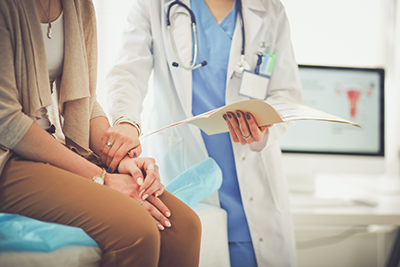Uterine Fibroid Treatment
 Finding a uterine fibroid treatment that fits your needs
Finding a uterine fibroid treatment that fits your needs
If you’ve been diagnosed with uterine fibroids, you’re not alone. These noncancerous, muscular growths in the uterus are often found in women of childbearing age. In fact, as many as 80 percent of women have uterine fibroids by age 50, according to CARE About Fibroids.
While uterine fibroids are common, they don’t affect every woman the same way. Fibroids can vary in number, size, location, and symptoms. These factors, along with your health and lifestyle, mean some treatments may fit your needs better than others.
Observation
Many uterine fibroids go undiagnosed or unnoticed. You may find out you have them after a routine pelvic exam. If your fibroids aren’t bothering you, your OB GYN may simply monitor them.
The American College of Obstetricians and Gynecologists says this approach is best if you aren’t having symptoms, your fibroids are small, or you’ve almost reached menopause. In some women, fibroids will get smaller on their own after menopause.
Treatment with medications
When your fibroids cause minor symptoms, you may try medication. If your main symptom is heavy bleeding, low-dose birth control pills or intrauterine devices can help. The hormones in these options usually reduce bleeding. If you have heavy bleeding that causes anemia, your OB GYN may also have you take an iron supplement.
Another option is gonadotropin-releasing hormone agonists (GnRHa). This type of medication can help reduce the size of uterine fibroids. However, it often causes side effects—like bone loss, hot flashes, or vaginal dryness. Because of this, the U.S. Department of Health and Human Services says you’ll typically use GnRHa for a short period.
Nonsurgical uterine fibroid procedures
Some women choose a procedure called uterine artery embolization (UAE) to treat fibroids. This procedure uses a small incision in your groin and a thin tube called a catheter to reach the arteries in your uterus. Your doctor then injects tiny particles to block off the small arteries that supply blood to your fibroids. By cutting off blood flow, the fibroids shrink.
While this procedure is an option for some, it isn’t a good fit for every woman. For example, the National Women’s Health Network says those who plan to have children later should talk about the risks with their doctor. UAE can increase the risk of some pregnancy and childbirth complications.
Surgery for uterine fibroids
If your symptoms are moderate to severe or if other treatments haven’t helped, you have surgical options. According to the Office on Women’s Health, uterine fibroids are the most common reason women choose a hysterectomy. Because this surgery completely removes your uterus, it’s the only procedure that makes sure fibroids don’t grow back.
Another option is endometrial ablation. An ablation destroys the lining of the uterus without an incision as a way to control bleeding. However, it isn’t recommended for women who are post-menopausal, have certain uterine conditions, or want to preserve their fertility. Others may choose myomectomy. This surgery removes fibroids but leaves your healthy uterine tissue in place. It’s often the right option for a woman who wants to keep her uterus and the ability to have children.
No matter your situation, if uterine fibroids are affecting your life, it’s time to talk to your OB GYN. While treatments for uterine fibroids are typically effective and safe, you should consider the benefits and the risks of each. From medications to hysterectomy, your doctor can help you find a treatment that fits your life.
